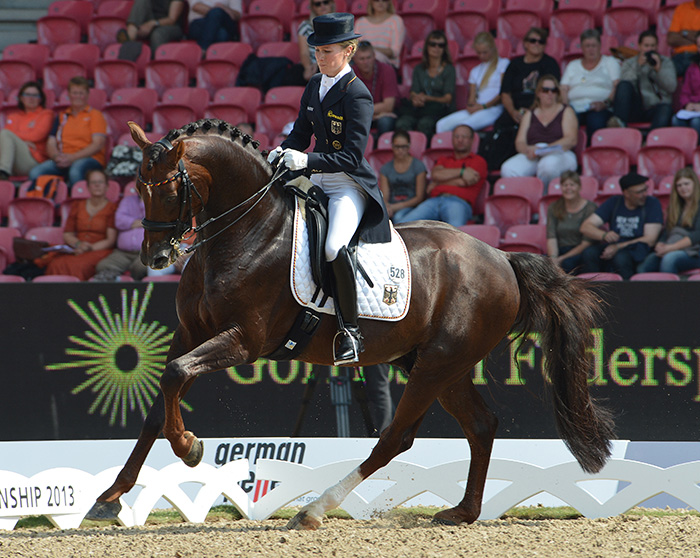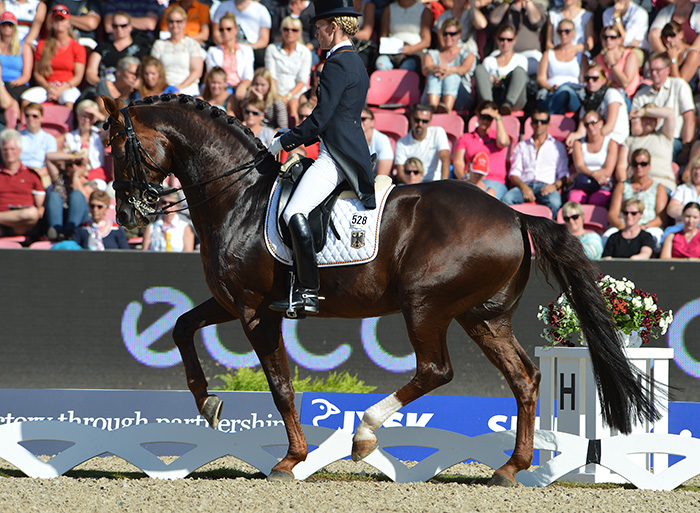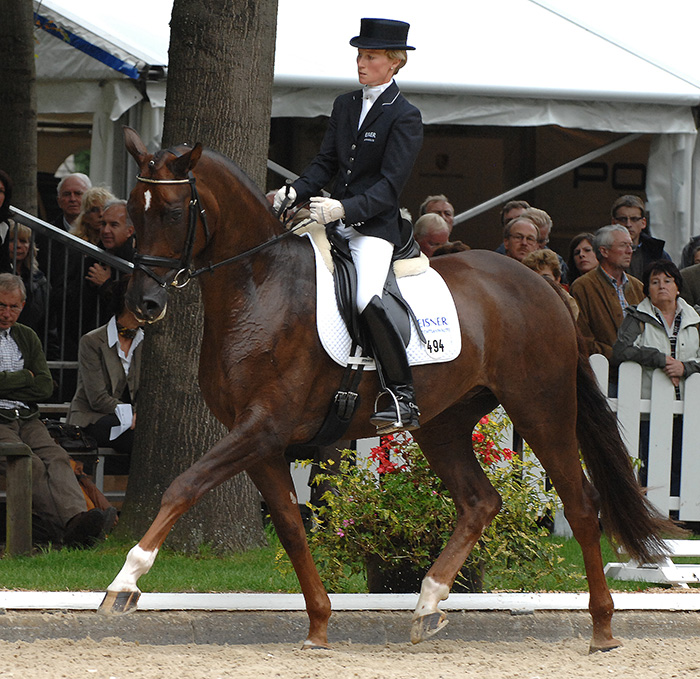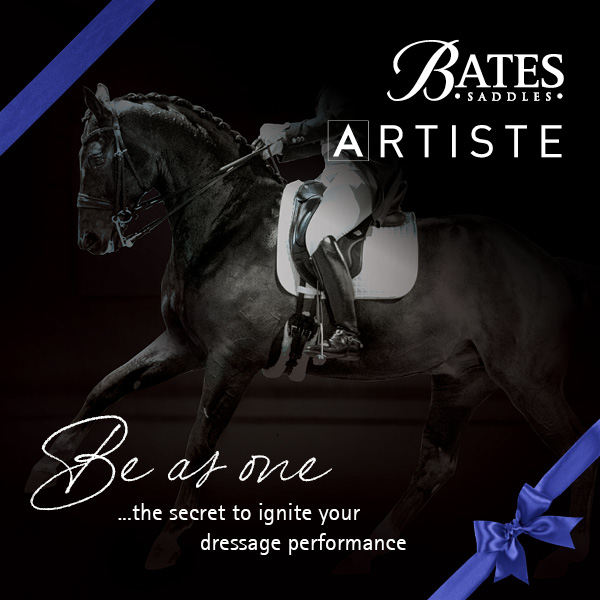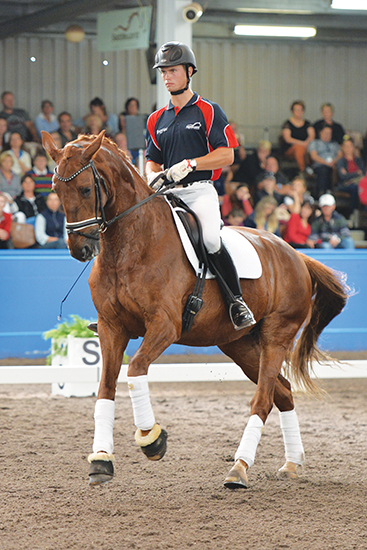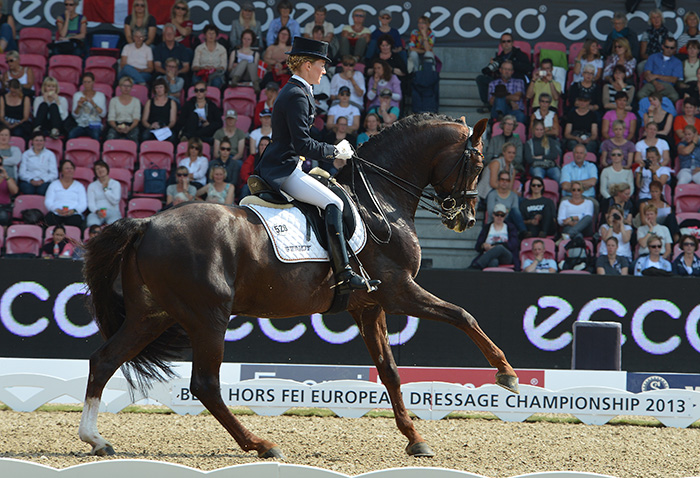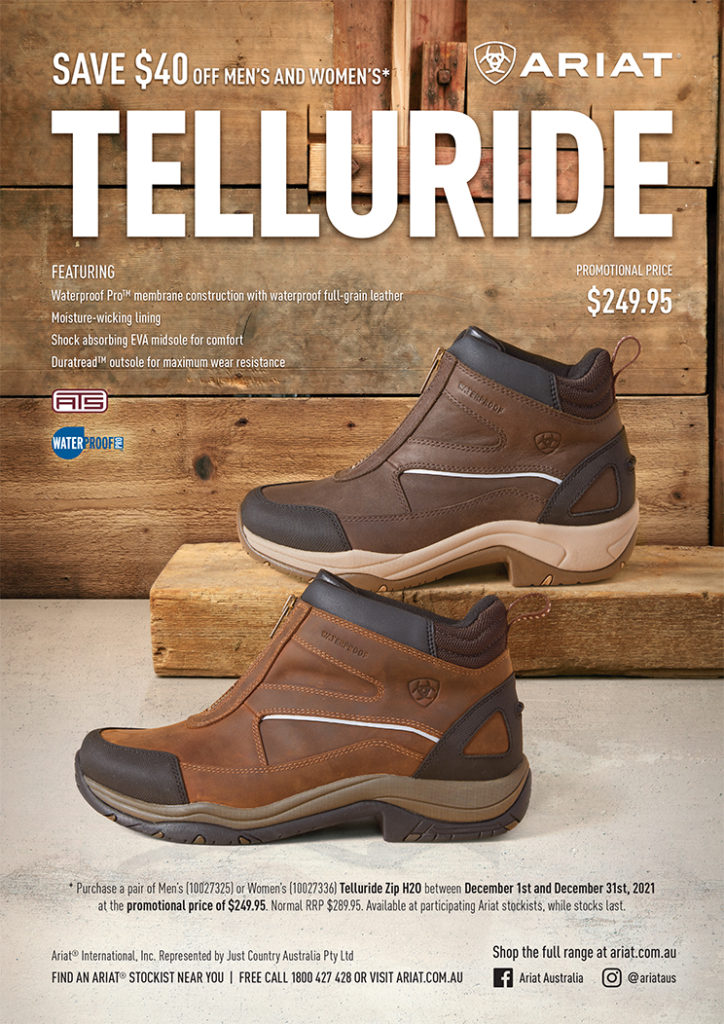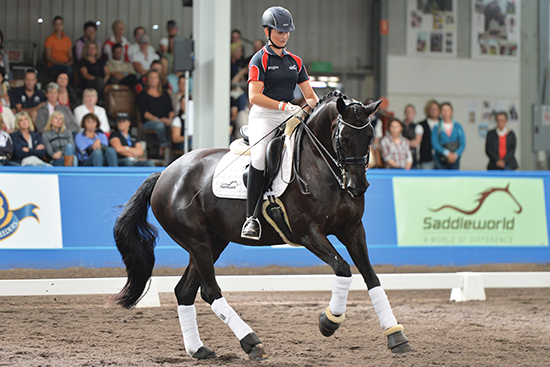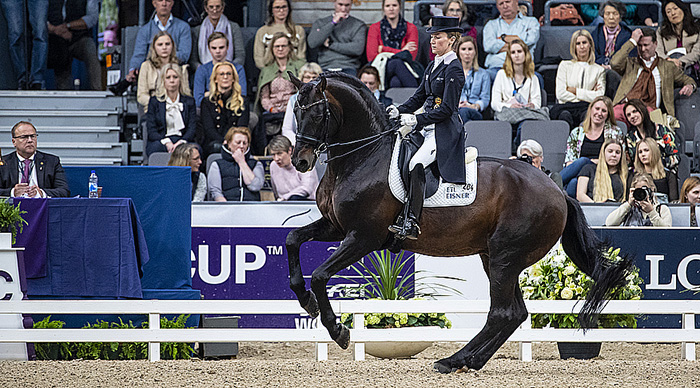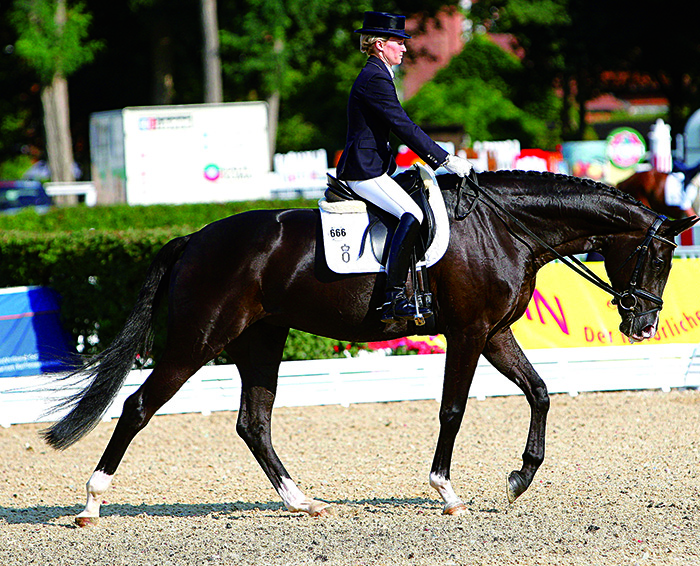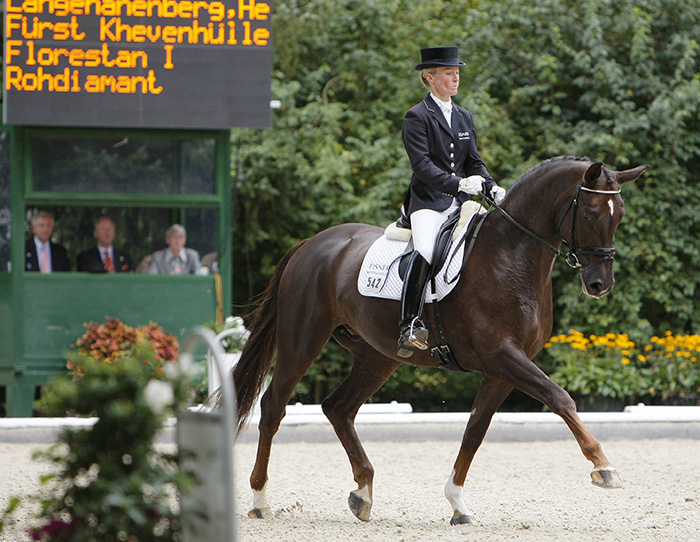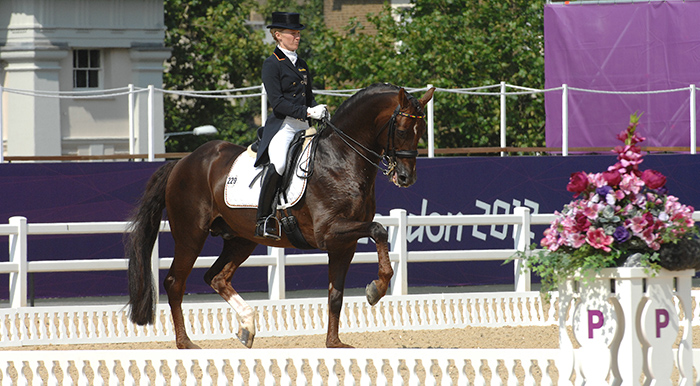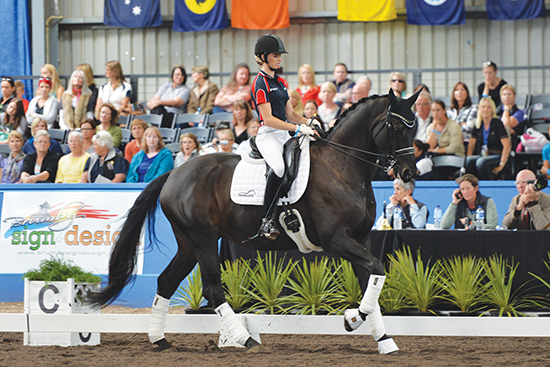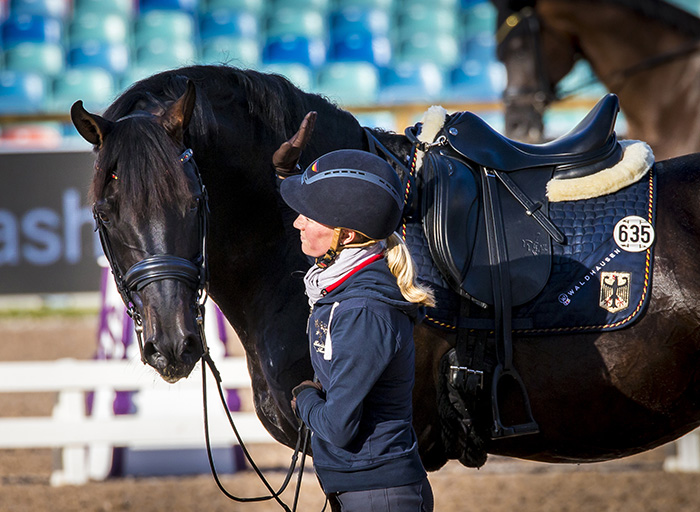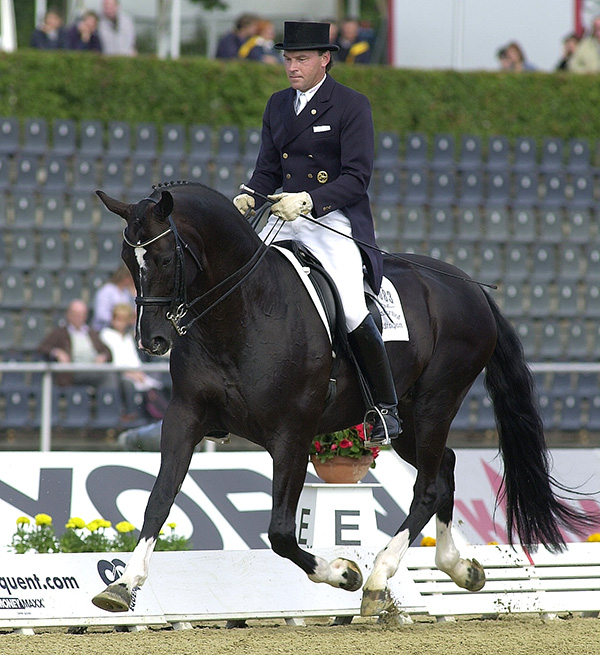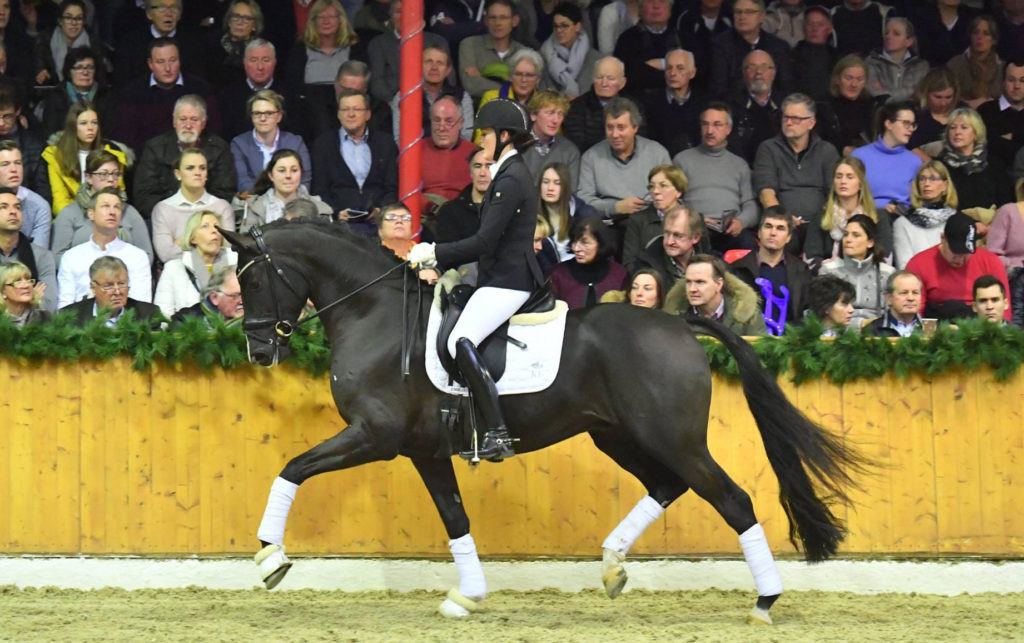Story and pix Ute Raabe, Ros Neave, and Rebecca Ashton
Enjoy a Masterclass with multi Medal winner for Germany, Helen Langehanenberg. Helen talks about feel, thoroughness and the importance of the horse knowing what we are asking…
“We want to see our horse collected, in an uphill position and on the bit, but we also want to feel our horse, and for our horse to feel us, dressage has to be a partnership”.
Helen and Damon Hill demonstrate
First horse in the arena was Yarramee Poetry, a four-year-old mare by Royal Hit, owned and ridden by Sharyn McCombe.
“Take your time, don’t worry about her being too high in the neck. You want to feel the connection. From the tail to the neck we want the same flexion and bend. Although she is hot, you ask her to work from behind.”
“Ask her to stay with you, keep the contact until she is ready to stay at your pace. When you feel that she starts to stretch, give the reins a little bit, but only so much that she will follow. Talk to her, she has to learn to be trustful to the rider. Then she will relax, because she knows that her rider will take care of her.”
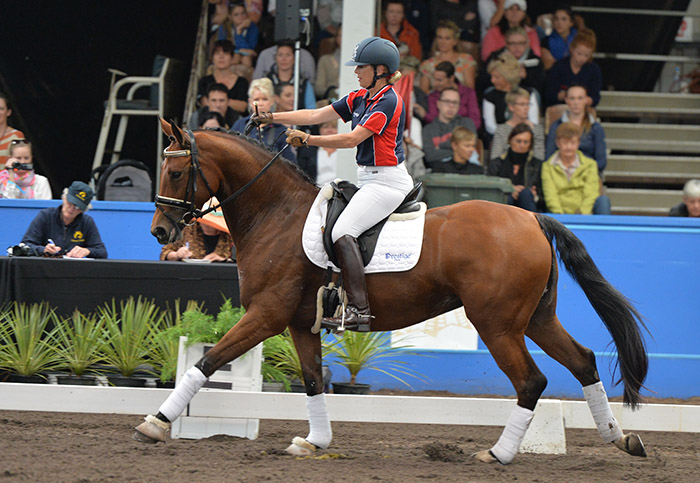
“When you can feel the contact, keep on cantering for one or two rounds, so the horse can experience this feeling in its body as well. If you change something, for example you ask for bending and shorten the rein on one side, you keep the bend for a moment, to give your horse a chance to feel what the rider wants.”
“You want to feel the connection. From the tail to the neck we want the same flexion and bend”. Helen and Damon Hill at the European Championships in 2013
Next is Reventon (by Regazzo), a former eventer, and Georgia Connolly.
“There’s no right or wrong way to start the working session, it depends on the horse”.
“If your horse loves to canter, start with the canter work. With this horse we decided to start with trot work, he is already warmed up, so with little transitions we will try to improve his trot work.”
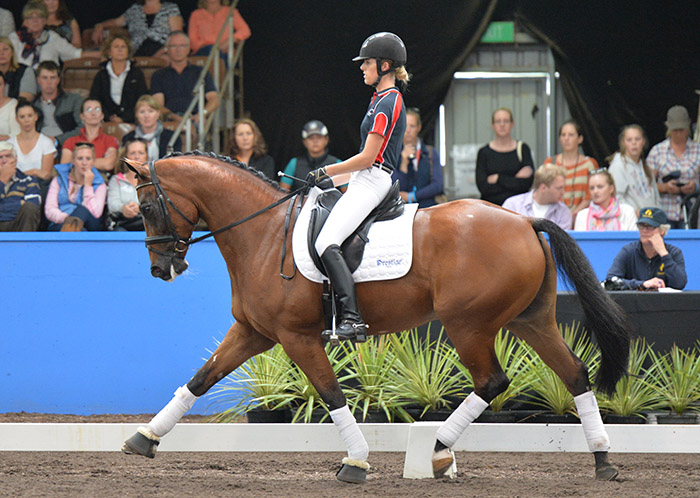
“Do less with your hand, sit quietly, use your leg to collect him. Just normal working trot, sit, close the leg, keep the contact, and out of this closing leg aid you ask the horse to close itself, move more under the centre of gravity and carry more weight.”
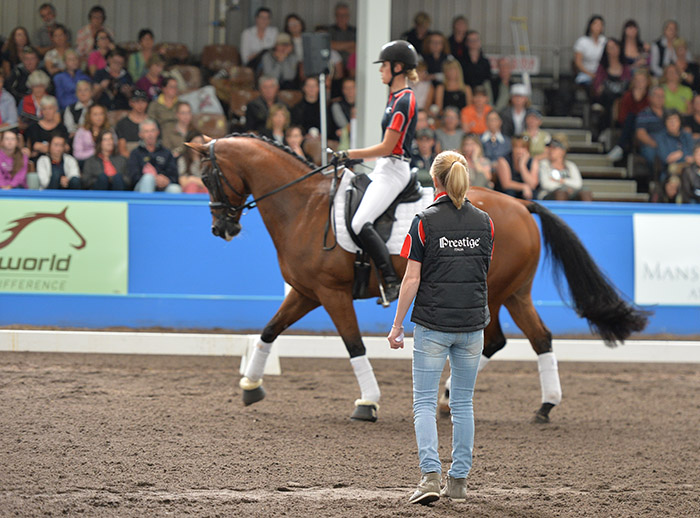
“Out of this we can start lateral work, first the shoulder-in. With the flexion and bending from the corner, you move into the shoulder-in and ride forward to the outside rein.”
Helen on her way to a win at the Bundeschampionships with Fürst Khevenhüille, a Florestan son
“Out of the corner I would like to see three legs if I am looking from the front: the outside front leg should cover the inside hindleg, ride a small circle in the corner first to establish the flexion.”
“Don’t always ride on the long side, you can look to a point at the end of the arena, and ride to this point, so that you both learn to balance on a free line.”
“When teaching half pass, firstly we train leg yielding and the crossing of the horses’ legs, then we train the bending. Then we put this puzzle together. We are not starting the half pass like ‘I want to go there, I need flexion here’, the horse may move sideways but he will have a big question mark in his eyes and says ‘what should I do?’”
“Ride across the diagonal in haunches in, that’s how you can play with the horse and make it easy for him to learn the half pass. Choose your line and then step by step, make a half pass out of it.”
Next Helen talks about, and shows us, flying changes
Boronia and Elliott focussing on changes
With the recently imported Boronia (Breitling) ridden by Elliott Patterson, the focus is on training flying changes.
Helen and Damon Hill demonstrate
“Practise the changes from the circle, through the circle, from the counter canter, do it at different positions, so your horse is not anticipating the movement. Use the short sides, the corners, that’s your time to prepare something. Always work between the changes, try to improve the canter between the changes.”
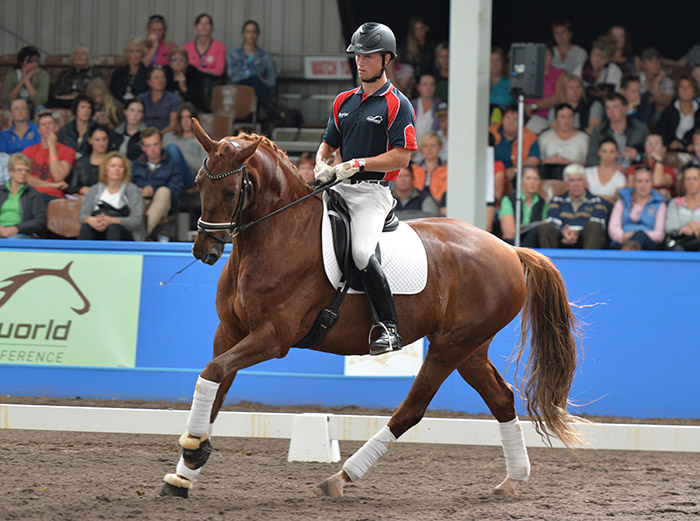
Helen emphasizes that it is important to have a plan of what you want to work on before every ride. “Think about what you want to do, and if your horse was good, don’t continue with the next exercise or movement. Keep the horse fresh and motivated to go.”
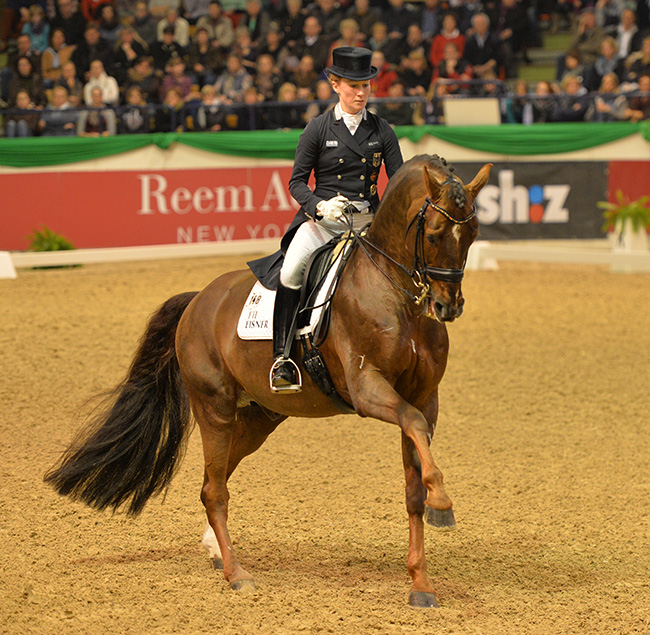
Damon Hill and Helen show us a change
another horse and rider next
Rocaille and Sara start with haunches-in
We see this principle applied to Rocaille, an eight-year-old Oldenburger mare by Rubinero who is competing at medium/advanced level with Sara McDonald. Rocaille tires quickly and so Helen has decided to begin with the movements she finds difficult – pirouette work.
“Start with haunches-in. Ask for less collection, make it less difficult, explain to her how to use her body. The inside hind leg is jumping a little sidewards now, but later on, for the pirouette, it can jump easily under the centre of gravity. We don’t want the horse to lean to one side as they jump sideways. We want our horses to be round and around our inside leg, in an active collected, or even a working canter.”
Helen talks about her current star, Damsey
“I think Damsey is the king of pirouettes. I always feel once I am in, I could do 50 pirouettes. He doesn’t care, he’s just doing it…”
“Don’t try to make the the first attempt perfect, it’s about explaining the movement to the horse. Stay soft and give the inside rein, but remain in the flexion and bend and give the aid until the horse is ready to do the movement and has understood what the rider wants. It might not be perfect, but you have to feel that the horse tries.”
Helen and Silberaster demonstrate a stretch
“That’s what I like as well, keeping the contact and working the horse like a young horse in between, let her stretch forward, keep it easy for her, she has an active break in canter.”
“Now bring her uphill again, always ask the horse to react on one aid and then keep it sensitive. Say once ‘here I am’, a horse that reacts immediately, has been given a clear aid. Otherwise the horse will question ‘what does my rider want to do’, it will start to become the boss and that’s when problems start. Clear aids, clear leadership, the horse knows what to do and then they like to do it.”
Sara canters with haunches-in on a small circle around Helen. “First you start with flexion and bending. When you feel that your horse is going against the bit, keep the bending, but don’t pull backwards. In that moment you also ask for more activity from behind, so the horse can jump into the bend. The more you collect the more you want to feel the jump in the canter stride, the three-beat.”
“When you make the transition to walk, you come through a three-beat, don’t stop by making a hard transition and all legs are hitting the ground hard. Ride a smooth transition; you want to feel the three-beat. Feel that the last canter stride is a proper canter stride, and then you have the four-beat in the walk.”
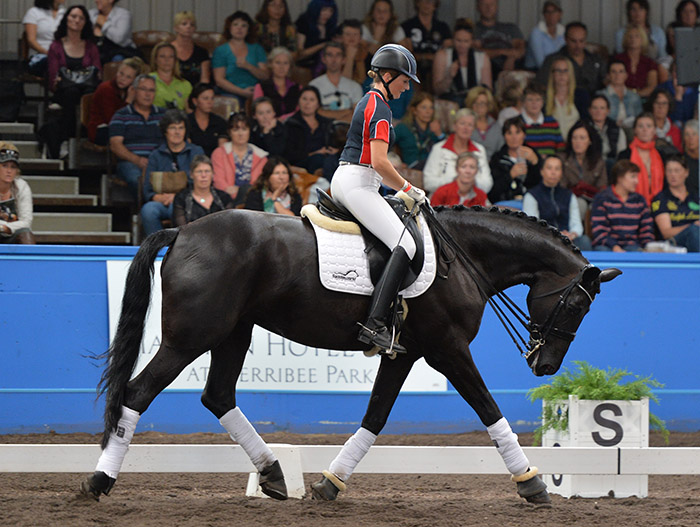
“Now give her the reins completely so that she can find a neck position in which she can relax. When you return to trot work and the mare is getting tired, you can allow her not to be in this perfect uphill position, but still work if you want to improve her condition and make her more powerful. Allow her to search for a contact where she feels well.”
“Always give them free days, don’t practise dressage movements seven days a week. You can do a little bit of jumping, hacking, give them different ideas of using their body. Keep it interesting.”
Next Helen discusses passage with Anthony Bartlett:
“Very important, don’t always go straight on the track, you go on a circle or on big lines through the arena so that you always bend him and ask for more flexion and activity. Take this with you into the collection. Come towards the passage work now, hands together in front of you.”
“Play with the passage, collect the passage and go out of the passage. Step by step you can improve it, work from behind and make him swing into the passage to improve the two-beat.”
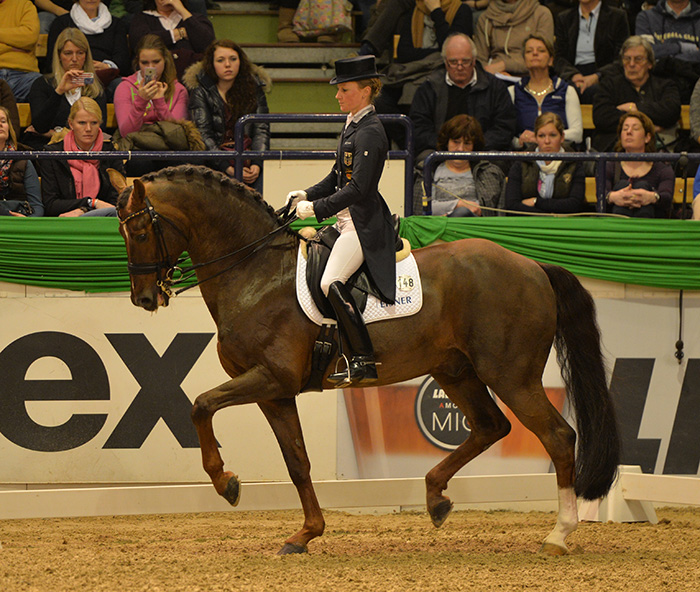
Helen and Damon Hill demonstrate a winning passage at Neumünster
“Out of this we can commence the piaffe work. What I always like to do in the beginning is doing it out the trot. Trot–piaffe–trot–piaffe. Use the energy of the trot to ride into the piaffe and do some quick transitions after each other. Make him quick with your seat, think of extension in the piaffe.”
The final centre line at the London Games…
“If the horse turns a little in piaffe, allow it, he’s learning. You ask for something and you give them something. Play with the piaffe and passage work, make a game out of it. Make him active through quick transitions, not by pushing him all the time. It will make him react softer, be more sensitive. The transitions are the important part, not the piaffe on its own.”
Shanon and Ambassi competing Grand Prix
The final pair we see are the combination of KWPN gelding Ambassi (Samba Hit) and Shanon McKimmie, competing Grand Prix.
“From easy to difficult, start with a long half pass in canter through the diagonal, the same to the right, jump towards the inside rein.”
“When you train these zig-zag half passes, you want to have the feeling that they belong together. It has to be a fluent transition from the right to the left, from the left to the right. When you are cantering to the right, you can start bending to the left, but still canter to the right until you feel the point of balance: go straight and at that moment do the flying change. You already have the flexion and bending for the new direction, you can fluently move into the new direction with the forehand leading and a new inside leg supporting the horse.”
“The Grand Prix test requires five half passes to either side of the centre line with a flying change at each change of direction, the first and the last half pass are three strides, the others are six strides. You have to count the canter strides, the change is the first canter stride into the new direction.”
Next some pirouette work…
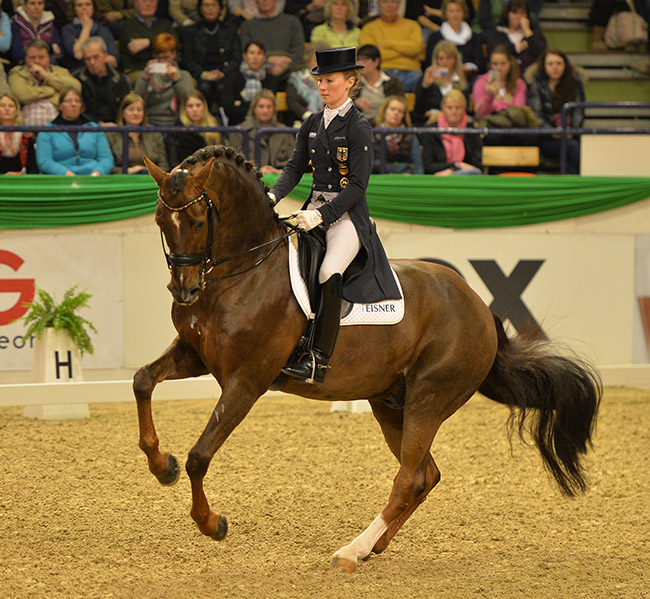
“Although you collect, you still want to feel the canter jump, the inside leg should jump far under the centre of gravity, not become short, you want to feel the same rhythm. In the working pirouette you jump around the inside hindleg. However small you get, you should always have the feeling of cantering around something, even if you imagine a very small plate. Keep the forward tendency, if he comes behind the leg, go forward.”
“Change your routine, always do the pirouette in a different way. Go on the centreline and start with the idea of a working pirouette, after starting big, you get very small. You can change the horse during the pirouette, this exercise is really good as it gives you safety for the test.”
“That’s what I like about this horse, he’s trying. If you see him just walking on a long rein, he doesn’t have the perfect body. He’s tall, he’s short in the body, his neck is too deep and not as round as you would like. But when Shanon takes the reins up, he has no weakness. He can work perfectly with his body and is able to carry weight. A good conformation helps, but it really depends on the horse itself.”
“I like to bring my horses back to the stable when they are still fresh. They can sweat, but the muscles should not be tired, they should not feel like ‘not again’, rather like ‘oh we could do something else’. I prefer them to be keen on the next day, to come out looking forward to their work.”
The current star, another D line representative, Damsey
Want to breed a D line dressage horse? How about the best producer of them all – De Niro – find out how, go to www.ihb.com.au
Or Danciero?



